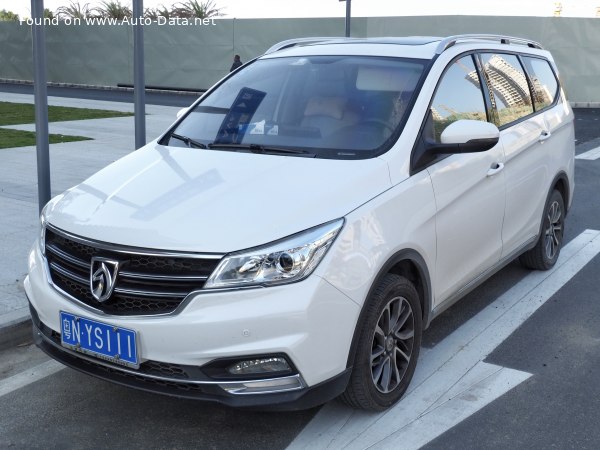


| What is the body type, Baojun 730 II? | MPV, 5 Doors, 7 Seats |
|---|---|
| What is the fuel economy, Baojun 730 II 1.5T (155 Hp) Mild Hybrid? | 6.3 l/100 km 37.3 US mpg 44.8 UK mpg 15.9 km/l |
| How ECO is the car, Baojun 730 1.5T (155 Hp) Mild Hybrid? | China V |
| How fast is the car, 2018 730 II 1.5T (155 Hp) Mild Hybrid? | 170 km/h | 105.63 mph |
| How much power, Baojun 730 MPV 2018 1.5T (155 Hp) Mild Hybrid? | 155 Hp |
| What is the engine size, Baojun 730 MPV 2018 1.5T (155 Hp) Mild Hybrid? | 1.5 l 1451 cm3 88.55 cu. in. |
| How many cylinders, 2018 Baojun 1.5T (155 Hp) Mild Hybrid? | 4, Inline |
| What is the drivetrain, Baojun 730 II MPV 2018 1.5T (155 Hp) Mild Hybrid? | Front wheel drive. MHEV (Mild Hybrid Electric Vehicle, power-assist hybrid, battery-assisted hybrid vehicles, BAHV). The Internal combustion engine (ICE) and electric motor drive the front wheels of the car with the ability to work only in mixed mode. |
| How long is this vehicle, 2018 Baojun 730 MPV? | 4780 mm 188.19 in. |
| How wide is the vehicle, 2018 Baojun 730 MPV? | 1780 mm 70.08 in. |
| What is the curb weight, 2018 Baojun 730 II 1.5T (155 Hp) Mild Hybrid? | 1540 kg 3395.12 lbs. |
| How many gears, What type is the gearbox, 2018 Baojun 730 II 1.5T (155 Hp) Mild Hybrid? | 6, manual transmission |
| General information | |
|---|---|
| Brand | Baojun |
| Model | 730 |
| Generation | 730 II |
| Modification (Engine) | 1.5T (155 Hp) Mild Hybrid |
| Start of production | November, 2018 year |
| End of production | August, 2022 year |
| Powertrain Architecture | MHEV (Mild Hybrid Electric Vehicle, power-assist hybrid, battery-assisted hybrid vehicles, BAHV) |
| Body type | MPV |
| Seats | 7 |
| Doors | 5 |
| Performance specs | |
| Fuel consumption (economy) - urban | 8.1 l/100 km
29 US mpg 34.9 UK mpg 12.3 km/l |
| Fuel consumption (economy) - extra urban | 5.3 l/100 km
44.4 US mpg 53.3 UK mpg 18.9 km/l |
| Fuel consumption (economy) - combined | 6.3 l/100 km
37.3 US mpg 44.8 UK mpg 15.9 km/l |
| Fuel Type | Petrol (Gasoline) |
| Maximum speed | 170 km/h 105.63 mph |
| Emission standard | China V |
| Weight-to-power ratio | 9.9 kg/Hp, 100.6 Hp/tonne |
| Electric cars and hybrids specs | |
| Battery voltage | 48 V |
| Battery technology | Lithium-ion (Li-Ion) |
| Internal combustion engine specs | |
| Power | 155 Hp |
| Power per litre | 106.8 Hp/l |
| Engine layout | Front, Transverse |
| Engine displacement | 1451 cm3 88.55 cu. in. |
| Number of cylinders | 4 |
| Engine configuration | Inline |
| Number of valves per cylinder | 4 |
| Fuel injection system | Multi-port manifold injection |
| Engine aspiration | Turbocharger, Intercooler |
| Valvetrain | DVVT |
| Engine oil specification |  Log in to see. Log in to see. |
| Space, Volume and weights | |
| Kerb Weight | 1540 kg 3395.12 lbs. |
| Fuel tank capacity | 52 l 13.74 US gal | 11.44 UK gal |
| Dimensions | |
| Length | 4780 mm 188.19 in. |
| Width | 1780 mm 70.08 in. |
| Height | 1775 mm 69.88 in. |
| Wheelbase | 2750 mm 108.27 in. |
| Front track | 1546 mm 60.87 in. |
| Rear (Back) track | 1541 mm 60.67 in. |
| Drivetrain, brakes and suspension specs | |
| Drivetrain Architecture | The Internal combustion engine (ICE) and electric motor drive the front wheels of the car with the ability to work only in mixed mode. |
| Drive wheel | Front wheel drive |
| Number of gears and type of gearbox | 6 gears, manual transmission |
| Front suspension | Independent type McPherson |
| Rear suspension | Independent multi-link suspension |
| Front brakes | Ventilated discs |
| Rear brakes | Disc |
| Assisting systems | ABS (Anti-lock braking system) |
| Steering type | Steering rack and pinion |
| Power steering | Electric Steering |
| Tires size | 205/55 R16 |
| Wheel rims size | 16 |